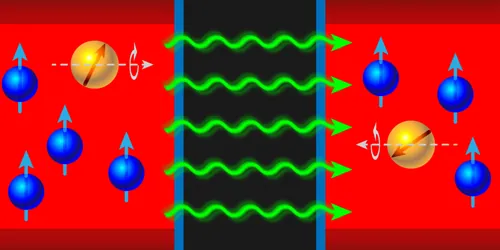
Uncovering the Mysteries of Dark Matter: The Search for Axions in Polarized Gases
2024-11-04
Author: Noah
Introduction to Dark Matter and Axions
Scientists are venturing into the enigmatic realm of dark matter through groundbreaking experiments using polarized gas. In their latest research, a team led by Haowen Su from the University of Science and Technology of China has conducted a comprehensive search for axions—an elusive and exotic particle speculated to make up a significant portion of dark matter.
The Limitations of the Standard Model
For decades, physicists have relied on the standard model of particle physics, which has proven effective at describing a mere 5% of our universe’s energy density. This frustration has propelled researchers to investigate beyond this established framework, looking for particles and forces that lie just outside its reach. Among the leading contenders in this search is the axion, a notoriously light particle proposed in the 1970s to resolve certain mysteries in particle physics.
Experimental Setup
To conduct their experiment, Su and colleagues utilized polarized xenon gas, examining the interactions between the xenon nuclei and potential axion-mediated interactions. By polarizing xenon-129 atoms through a process called spin-exchange optical pumping with rubidium-87, they created a unique scenario where these atoms could reveal the signature of axion-related phenomena.
Methodology
The research team strategically designed their setup around two separate cells filled with this polarized gas, separated by 60 millimeters. They applied a magnetic field to one cell to induce a precession effect in the spins of the xenon atoms, which could potentially reveal signatures of axion interactions. By suppressing traditional magnetic-field interactions with strategic shielding, they were able to hone in on these elusive signals.
Results and Implications
While the results of the experiment revealed no evidence of axions, the enhancements in their methodology—particularly through magnetic amplification and signal templates—marked a significant leap in sensitivity, improving detection limits of axion interactions by a factor of 50 in a critical mass region relevant to dark matter research. This newfound capability opens doors for future experiments that could explore other mysterious influences in the universe, such as interactions stemming from decaying dark matter or signals from cosmic events like binary black hole mergers.
Conclusion
The search for axions is not merely an academic exercise; it holds the potential to unlock the secrets of dark matter, which constitutes approximately 27% of the total mass-energy content of the universe. As researchers continue to refine their techniques and expand the parameters of their experiments, the quest to fully understand dark matter and its implications for the cosmos persists.
Stay Tuned
Stay tuned for more developments in this fascinating journey to uncover the fundamental secrets of the universe!









 Brasil (PT)
Brasil (PT)
 Canada (EN)
Canada (EN)
 Chile (ES)
Chile (ES)
 España (ES)
España (ES)
 France (FR)
France (FR)
 Hong Kong (EN)
Hong Kong (EN)
 Italia (IT)
Italia (IT)
 日本 (JA)
日本 (JA)
 Magyarország (HU)
Magyarország (HU)
 Norge (NO)
Norge (NO)
 Polska (PL)
Polska (PL)
 Schweiz (DE)
Schweiz (DE)
 Singapore (EN)
Singapore (EN)
 Sverige (SV)
Sverige (SV)
 Suomi (FI)
Suomi (FI)
 Türkiye (TR)
Türkiye (TR)